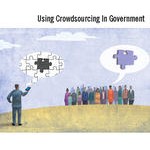 The growing interest in “engaging the crowd” to identify or develop innovative solutions to public problems has been inspired by similar efforts in the commercial world. There, crowdsourcing has been successfully used to design innovative consumer products or solve complex scientific problems, ranging from custom-designed T-shirts to mapping genetic DNA strands.
The growing interest in “engaging the crowd” to identify or develop innovative solutions to public problems has been inspired by similar efforts in the commercial world. There, crowdsourcing has been successfully used to design innovative consumer products or solve complex scientific problems, ranging from custom-designed T-shirts to mapping genetic DNA strands.
The Obama administration, as well as many state and local governments, have been adapting these crowdsourcing techniques with some success. This report from IBM provides a strategic view of crowdsourcing and identifies four specific types for use in government:
- Type 1: Knowledge Discovery and Management. Collecting knowledge reported by an on-line community, such as the reporting of earth tremors or potholes to a central source.
- Type 2: Distributed Human Intelligence Tasking. Distributing “micro-tasks” that require human intelligence to solve, such as transcribing handwritten historical documents into electronic files.
- Type 3: Broadcast Search. Broadcasting a problem-solving challenge widely on the internet and providing an award for solution, such as NASA’s prize for an algorithm to predict solar flares
- Type 4: Peer-Vetted Creative Production. Creating peer-vetted solutions, where an on-line community both proposes possible solutions and is empowered to collectively choose among the solutions.
By understanding the different types, which require different approaches, public managers will have a better chance of success. Dr. Brabham focuses on the strategic design process rather than on the specific technical tools that can be used for crowdsourcing. He sets forth ten emerging best practices for implementing a crowdsourcing initiative.”